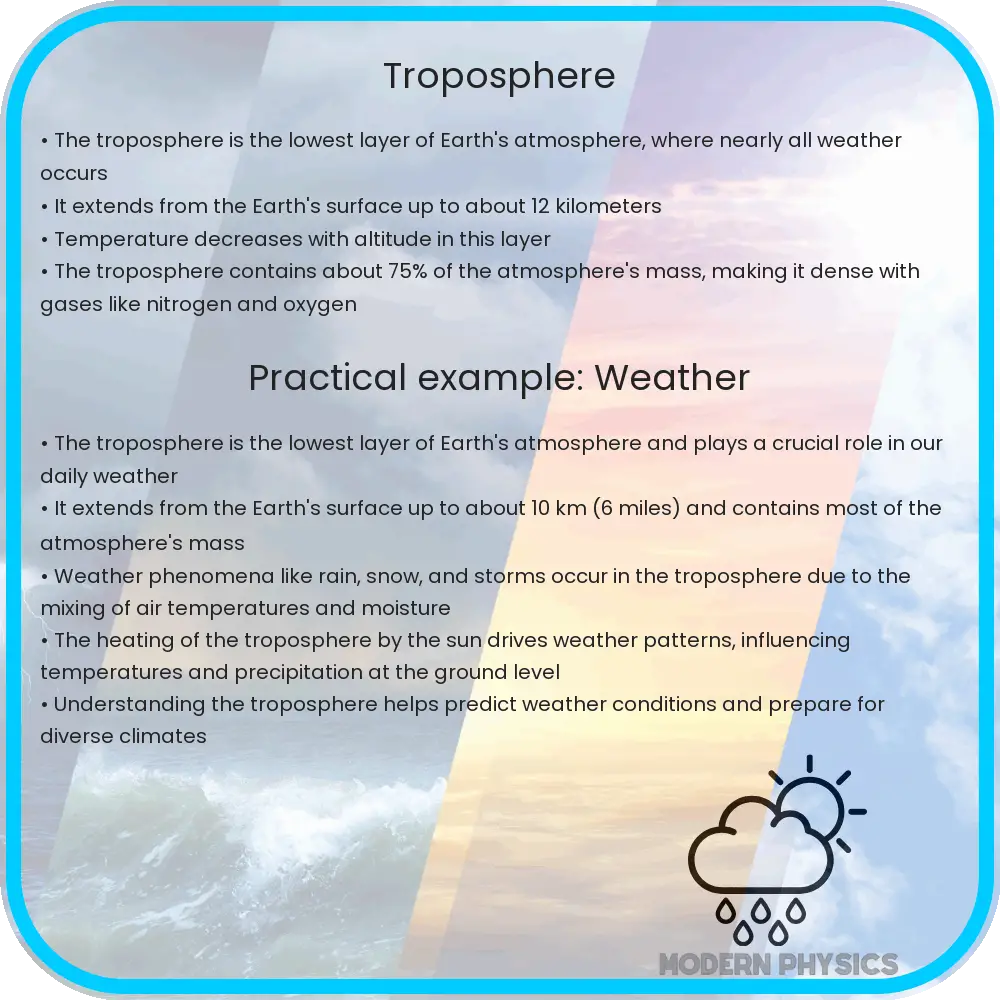Uncover the complexities of the troposphere, the lowest layer of Earth’s atmosphere, essential for climate and weather dynamics.

Understanding the Troposphere: Composition and Atmospheric Dynamics
The troposphere is the lowest layer of Earth’s atmosphere and plays a critical role in the dynamics of our planet’s weather and climate. Extending from the Earth’s surface to roughly 8 to 15 kilometers (5 to 9 miles) above sea level, the troposphere is a bustling arena of environmental activity. Its behavior significantly impacts life on Earth, influencing everything from global weather patterns to local climatic conditions.
Composition of the Troposphere
The troposphere is primarily composed of nitrogen (78%) and oxygen (21%). The remaining 1% consists of argon, carbon dioxide, and traces of other gases. Besides these gases, the troposphere contains varying amounts of water vapor, which plays a vital role in the form of clouds and precipitation, influencing heat distribution and climate dynamics.
Moreover, the composition of the troposphere is not uniform; it varies with altitude, latitude, and weather conditions. The presence of aerosols and pollutants, which are small particles or droplets suspended in the atmosphere, can also affect air quality and climate through processes like scattering and absorption of sunlight.
Atmospheric Dynamics of the Troposphere
The troposphere is dynamically active, with temperature and pressure decreasing with altitude. This temperature gradient, along with the influence of Earth’s rotation, fuels the complexity of weather systems. The fundamental principles governing these systems can be explained through various physical laws and atmospheric conditions.
- Temperature Gradient: Typically, the temperature within the troposphere decreases with height at an average lapse rate of about 6.5 degrees C per 1000 meters (3.6 degrees F per 1000 feet).
- Pressure Changes: Air pressure decreases with altitude. The rapid decrease in air pressure at higher elevations has significant implications for weather patterns and the movement of air masses.
The behavior of the troposphere is also influenced by the concept of convection. Warmer air near the Earth’s surface rises due to being less dense, while cooler air descends. This cycle, influenced by the Earth’s rotation, drives the predominant weather patterns seen across the globe.
- Hadley Cell: It involves the rising of warm air near the equator, moving poleward at high altitudes, sinking at medium latitudes, and returning equatorward near the surface.
- Ferrel and Polar Cells: These cells exist as part of a greater atmospheric circulation pattern and contribute to the diverse climatic zones across the planet.
The interactions between temperature, wind, and pressure systems generate a vast range of weather phenomena, from thunderstorms to typhoons, heavily impacting ecosystems, human activity, and the overall environment.
The Role of the Troposphere in Weather Formation
Understanding the troposphere’s role in weather formation is essential for predicting weather changes and preparing for their impacts. Weather phenomena like wind, rain, snow, fog, and storms all originate within this atmospheric layer. Each weather event stems from the dynamics of the troposphere, influenced by its thermal structure and interactions with surface features such as oceans, mountains, and forests.
For instance, cloud formation results from the cooling of water vapor as it rises and expands in the decreasing pressure of the troposphere. Rain occurs when these clouds become saturated and cannot hold additional water vapor, leading to precipitation. The variability in such processes across different geographic areas and seasons underscores the complexity of tropospheric dynamics.
Human Impact on the Troposphere
Human activities also play a significant role in influencing the conditions within the troposphere. Industrial emissions, vehicular pollution, and the burning of fossil fuels release large amounts of carbon dioxide, methane, and other greenhouse gases into the atmosphere. These gases trap heat and contribute to global warming, which in turn alters the temperature gradient and atmospheric dynamics of the troposphere.
Beyond greenhouse gases, urbanization and deforestation also affect local and global atmospheric conditions. For instance, the replacement of vegetated areas with urban structures can lead to “urban heat islands,” where cities become significantly warmer than their rural surroundings. This increase in temperature can modify local weather patterns and potentially disrupt regional climate systems.
Monitoring and Predicting Tropospheric Changes
Given the troposphere’s critical role in determining the Earth’s climate and weather patterns, monitoring its changes is crucial for scientific research and public safety. Modern technology and methods like satellites, weather balloons, and radar systems are extensively used to gather data on atmospheric conditions. This data is crucial in developing accurate weather forecasts and climate models that predict how the troposphere might behave in the future under various environmental scenarios.
Advanced computational models that simulate atmospheric dynamics can help in understanding how changes in the troposphere might influence global climate patterns in the long-term. These models are essential tools for policymakers and scientists in planning for climate adaptation and mitigation strategies.
Conclusion
The troposphere is more than just the lowest layer of our atmosphere; it is a dynamic system that plays a pivotal role in the Earth’s weather and climate. From keeping life aloft with breathable air to containing the conditions necessary for weather phenomena, the troposphere’s balance and behavior are integral to our environment. Human activities and natural phenomena continuously shape its makeup, challenging us to predict and adapt to its changes wisely.
Understanding this vital atmospheric layer’s composition, mechanisms, and the impact of human actions on it not only aids in better weather predictions but also enhances our strategies for tackling broader environmental challenges. As we continue to study and learn about the troposphere, we deepen our appreciation of how interconnected and susceptible our planet is—and how essential it is to protect this fragile atmospheric layer that shields and sustains life on Earth.
